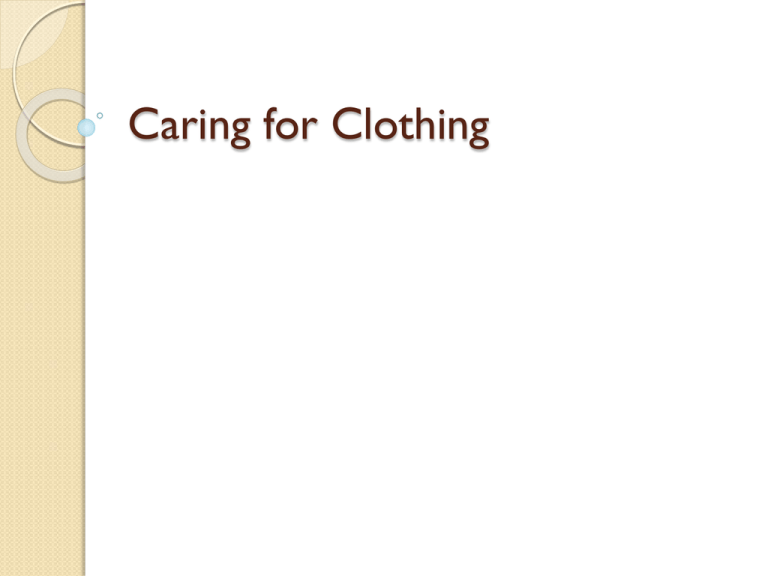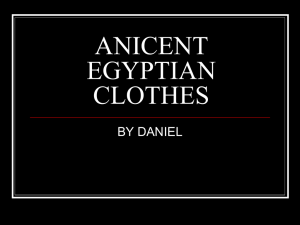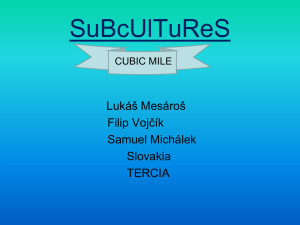Caring for Clothing
advertisement

Caring for Clothing Discussion How can organizing your clothing help make a little space seem like a lot more? What household items can be used for storage? Routine Care Open all fasteners ( buttons, zippers, snaps) when dressing to help prevent rips and tears Take your shoes off before getting in and out of pants Check for stains right after taking clothes off Remove stains as soon as possible Check for needed repairs Put dirty clothes in a laundry basket away from clean clothes Hang up or fold clothes that don’t need washing Storing Clothes Drawers ◦ Keeps smaller items in place ◦ Clothes will be less likely to wrinkle when you have ample storage space ◦ If you don’t have a lot of drawer space, use plastic containers Closets ◦ Organize clothes: Color Seasonal Long sleeve/short sleeve/ sweaters Family Activity What is your family technique for sorting and pretreating clothes? If you don’t know, watch tonight and ask. Washing Clothes Care Labels ◦ Label will tell you steps to follow to wash and dry clothing ◦ Also tells you what not to do with clothing Sorting Clothes ◦ Helps to prevent colors from running together ◦ Keeps garments in good condition ◦ Separate clothes into the following piles: Delicate fabrics that require warm water and a gentle cycle Sturdy white and light-colored clothing Permanent press and knit fabrics Dark-colored clothing Heavily soiled garments that should be washed separately Washing Clothes Pretreat clothes ◦ Any special attention you give a garment before laundering ◦ Helps to remove stains and heavy soil ◦ Necklines and cuffs need special attention ◦ Follow label directions ◦ Sometimes extra scrubbing with undiluted liquid can help the stained area L.A. Read laundry-product labels. What does each term mean? Washing Clothes Choose Laundry Products ◦ Detergents- primary job is to remove dirt ◦ Bleaches-used to remove stains, brighten clothes, and whiten ◦ Fabric softeners – reduce static cling , make fabric softer, and reduce wrinkles Select Cleaning Action Avoid overloading washer Hand washing ◦ Use a sink or container large enough for clothes to move freely ◦ Choose a soap or detergent to suit clothes ◦ Put water in the sink, add detergent, mix, and add clothes ◦ Soak clothes 5 to 30 minutes, depending on the amount of dirty clothes ◦ Drain the sink and add fresh water, gently squeeze sudsy water through garments. Use at least two rinses to remove both suds and soil Math Activity Read the Energy Guide label on a dryer. Find the cost of drying one load of clothes. How much energy does it use? What would be the annual cost? Annual amount of energy used? Drying Clothes Clothes can be air dried or dried in a dryer Generally, if it can be washed together it can be dried together Check information on care labels Shake out clothes before putting in a dryer Helps to dry faster Avoid overloading dryer-increases dry time and wrinkles Avoid over drying clothes- can cause shrinkage Clean lint filter- improve circulation and avoid a fire Air drying is an energy saver Pressing and Ironing Clothes Pressing- process of lifting and lowering the iron onto areas of fabric Ironing involves moving the iron back and forth over the fabric Knits and wools should be pressed to avoid stretching Woven fabrics can be ironed Temperature depends on the content Check care labels If it is a blend, set it on the lowest setting Press dark and wool fabrics inside-out to keep them from becoming shiny Ironing Discussion Convenient times to iron? Think of two times where you could be ironing while doing something else. Dry Cleaning Dry clean- to clean with chemicals rather than with water and detergent Garment is then cleaned and steamed to remove wrinkles Not all fabrics can be dry cleaned Check care labels Professional dry cleaning ◦ More expensive, but can remove more spots Coin operated machines ◦ Cost less, but don’t always provide special treatment for spot or stain removal.You must do your own pressing Clothing Repair Rips and Tears ◦ Easy to repair. Use thread that matches the color of the fabric ◦ Make a new line of stitching by hand or with a sewing machine ◦ Begin and end just beyond the ripped section ◦ Iron on mending tape can help repair clothes ◦ Can be repaired with patches Buttons ◦ Two types of buttons: Sew-through Comes up and through the button Should make a shank when you sew this button on Shank Underneath to hold the thread Snaps, Hooks, and Eyes ◦ Use black snaps for dark fabrics ◦ And silver for light ones ◦ Hooks and eyes- found on necklines, waistbands, or neck edges ◦ Colors for hooks and eyes- same as above






